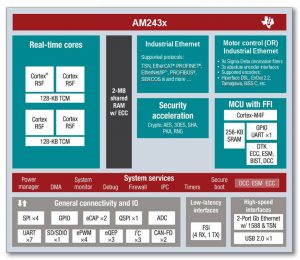
Called the AM2x series, the MCUs have multiple Arm Cortex-Rx real-time cores and, unlike other Sitara devices, no Cortex-Ax application processors.
The first members available will be numbered AM243x (see diagram) and have 800MHz Cortex-R5F cores.
“The AM2x family only features MCU real-time cores, along with specialised accelerators and I/O to meet specific design needs,” TI general manager Mike Pienovi told Electronics Weekly. “The AM243x device has code compatibility with the Sitara AM64x processor, so designers have the option scale their applications from an MCU to an MPU with pin-to-pin and software compatibility.”
Packaging is 17 x 17mm FCBGA or 11 x 11mm FC/CSP for the initially released:
- AM2431 single core
- AM2432 dual core (2x single core ‘clusters’)
- AM2434 quad core (2x dual core clusters)
Within a cluster there is shared tightly-coupled memory (see diagram).
Although none of them have a Cortex-A non-real-time core, all of them have a single 400MHz Cortex-M4 with its own resources that can operate in isolation from the real-time cores, or share its resources with them.
“Functional safety features can be enabled through the integrated Cortex-M4F along with its dedicated peripherals which can all be isolated from the rest of the SoC,” according to the company. “Integrated functional safety mechanisms, diagnostics and collateral help enable system integrators to target up to safety integrity level (SIL) 3 of IEC 61508.”
Gigabit industrial Ethernet and time-sensitive networking (TSN) is supported. TI has protocol stacks for EtherNet/IP, EtherCAT, PROFINET and IO-Link Master.
Security acceleration includes AES, 3DES and SHA crypto.
Applications are foreseen in motor drives, including within tight servo loops, and remote I/O modules.
“AM243x architecture was designed to provide real-time performance through Cortex-R5F cores, tightly-coupled memory banks, configurable SRAM partitioning and dedicated low-latency paths to and from peripherals, while the peripherals like FSI, GPMC, PWMs, sigma-delta decimation filters and absolute encoder interfaces help enable architectures found in these systems.”
The data sheet power consumption summary has been left blank (April 2021 version). According to TI, AM243x devices work “while consuming less than 1W of active power”.
Sitara AM243x LaunchPad development kit, plus the Sitara MCU+ software framework, is available for evaluation.
The AM243x Sitara data sheet is here – the first two pages are worth a browse just to see the long list of peripherals. Page three is devoted to functional safety features.